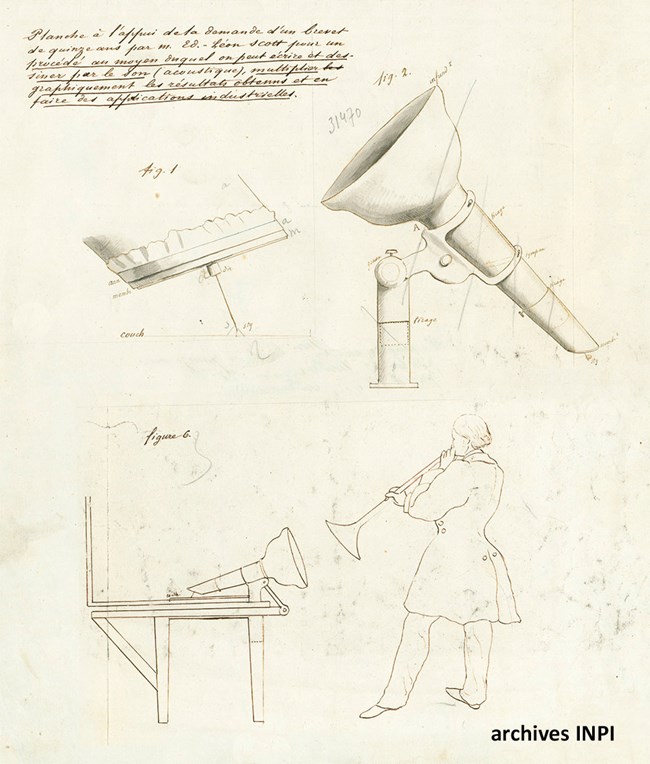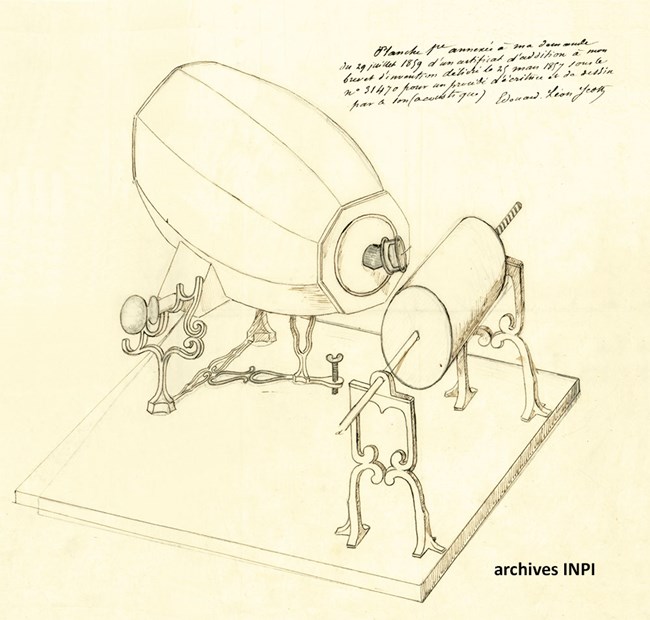
Edouard-Léon Scott de Martinville: The PhonautographEdouard-Léon Scott de Martinville invented sound recording 20 years before Thomas Edison invented the phonograph. Sound had been invisible and transient since the beginning of time. Scott’s phonautograph recorded it and made it both visible and permanent. It was a technological breakthrough, ahead of its time. He did not intend for his phonautograms to be played back; that concept was another 20 years away. When Edouard-Léon Scott de Martinville first conceived of sound recording he was an editor and typographer of manuscripts at a scientific publishing house in Paris. One day in 1853 or 1854 he was pouring over a text on human physiology when he envisioned an amazing new possibility. He called it “the imprudent idea of photographing the word.” If photography could capture fleeting images with lenses modeled on the eye, might not a replica of the ear similarly capture spoken words? 
Institut national de la propriété industrielle I cover a plate of glass with an exceedingly thin stratum of lampblack. Above I fix an acoustic trumpet with a membrane the diameter of a five franc coin at its small end—the physiological tympanum (eardrum). At its center I affix a stylus—a boar’s bristle a centimeter or more in length, fine but suitably rigid. I carefully adjust the trumpet so the stylus barely grazes the lampblack. Then, as the glass plate slides horizontally in a well formed groove at a speed of one meter per second, one speaks in the vicinity of the trumpet’s opening, causing the membranes to vibrate and the stylus to trace figures.
Scott called this process “phonautography”—the self-writing of sound. Of course he didn’t expect perfectly formed letters of the alphabet to emerge from the stylus. But he did believe the calligraphy inscribed in the soot—”the words that wrote themselves”—embodied a form of “natural stenography” that would someday be read as easily as a stenographer deciphered his own jottings. 
Société d'encouragement pour l'industrie nationale 
Institut national de la propriété industrielle
In 1857 the phonautograph captured the attention of SEIN (Société d'encouragement pour l'industrie nationale)—an association of experts that assessed new technologies and their potential contributions to French industry. Scott spent the summer and fall improving his invention with the support of SEIN and the guidance of its members. They upgraded from a pane of glass, which recorded only a snippet of sound, to a rotating cylinder that could record for 20 seconds or so. They experimented with different arrangements of the recording chain. They made experimental recordings which we can hear today using digital technologies.

Institut national de la propriété industrielle Gentlemen, we are in the presence of an invention being born—an entirely new graphic art springing from the heart of physics, of physiology, of mechanics. Each trace of speech that I submit today analyzes the voice: its tonality, its intensity, its timbre. I believe a synthesis is also possible through which the tracing of the words is transformed into a series of signs by mechanical means, and I propose to attempt it. I see the book of nature opened before the gaze of all men, and, however small I may be, I dare hope to be permitted to read it. In 1859 Scott teamed up with Rudolph Koenig, a builder of precision scientific instruments, to commercialize the phonautograph as a laboratory instrument in the nascent field of acoustical study. In his very first catalog Koenig wrote: Most empirical sciences possess of a wide range of specialized instruments that gather precise in-depth knowledge of their phenomena. In this sense acoustics trails other experimental sciences by a century, lacking instruments of observation, measurement and analysis, as did astronomy before the invention of the telescope. A means of dissecting sonorous phenomena—a microscope that not only shows sounds but preserves their imprint—is the gap the phonautograph proposes to fill. 
counting the vibrations inscribed by a 250 Hz tuning fork on the bottom. Académie des sciences-Institut de France In 1860 Scott made a number of recordings using this arrangement. He sang songs, he recited excerpts of poetry and plays in several languages. Along with his previous experiments these are humanity’s first recordings of its own voice. And they were made with a visionary time-code technology that would be rediscovered in the 20th century and become the backbone of all communication technologies.
This exhibit continues here: Thomas Edison: The Phonograph Go back to Who Invented Sound Recording? [ Return to The Origins of Sound Recording opening page. ] ——————————
|
Last updated: July 17, 2017
